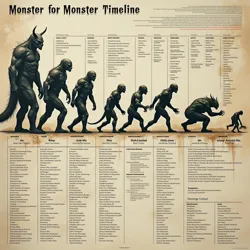Great Monster Drought
The Great Monster Drought refers to the marked decline in culturally impactful monster archetypes during the early decades of the 21st century. First identified by cultural anthropologist Dr. Sarah Chen in her 2015 paper "The Diminishing Pantheon: Monster Creation in the Digital Age," this phenomenon represents a significant shift in how society conceptualizes and creates its monsters. The drought stands in stark contrast to the prolific monster-creation periods of previous centuries, particularly the Victorian era's Gothic horror renaissance and the Cold War period's science fiction monsters.
 A visual representation showing the declining rate of new culturally significant monster archetypes from 1800-2025
A visual representation showing the declining rate of new culturally significant monster archetypes from 1800-2025Origins and Recognition
The term "Great Monster Drought" was formally introduced at the 2016 Monster Studies Institute symposium, where researchers noted that no new monster archetype had achieved the cultural staying power of classical creatures like vampires, werewolves, or even more recent additions like the xenomorphs from the Alien franchise. This observation led to the establishment of the Monster Design Renaissance Initiative, which sought to analyze and address the creative stagnation in monster design.
The drought became particularly apparent when compared to the rich monster-creating periods that preceded it. The 19th century produced enduring archetypes through the works of authors like Mary Shelley and Bram Stoker, while the 20th century generated numerous memorable creatures through cinema and television. In contrast, the 21st century has largely recycled and reinterpreted existing monster types rather than establishing new ones.
Cultural and Technological Factors
Several key factors contribute to the Great Monster Drought, many of which stem from fundamental changes in how modern society processes and expresses its fears. The rise of Information Parasites and other abstract digital threats has shifted horror away from physically manifested monsters toward more intangible dangers. This transition reflects broader societal anxieties about technology and interconnectedness that resist traditional monster personification.
The Digital Age Theory suggests that modern fears have become too complex and systemic to be effectively embodied in singular monster forms. While previous generations could channel their anxieties into concrete creatures like Dracula (representing fears of sexuality and foreign influence) or Godzilla (expressing nuclear anxieties), contemporary concerns about climate change, digital surveillance, and economic inequality prove more challenging to personify.
Impact on Creative Industries
The drought has significantly affected how horror and science fiction media are produced and consumed. Traditional monster-driven narratives have given way to more psychological horror and abstract threats. The emergence of Algorithmic Entities represents one attempt to bridge this gap, creating monsters that exist within digital spaces while maintaining some connection to classical horror tropes.
The entertainment industry has responded to the drought primarily through reimagining existing monsters rather than creating new ones. This trend has led to what cultural critics term the "Reboot Paradox," where attempts to modernize classic monsters often result in diminishing returns, further highlighting the difficulty of creating compelling new monster archetypes in the contemporary era.
Sociological Implications
The Great Monster Drought reflects deeper changes in how society processes and expresses collective fears. Modern threats often lack the physicality that made traditional monsters effective vehicles for social commentary. The Probability Phantom phenomenon demonstrates how contemporary monsters tend toward abstract concepts rather than tangible creatures, making them less accessible to mass audiences and harder to establish as cultural touchstones.
This shift has led to the development of new theoretical frameworks for understanding monster creation in the digital age. The Cryptozoological Futurists have proposed that the drought might actually represent a transition period rather than a creative dead end, suggesting that entirely new categories of monsters may be emerging that simply don't fit traditional definitions.
Academic Response
The academic community has responded to the Great Monster Drought with increased attention to monster studies as a serious field of cultural research. The establishment of dedicated research programs at several major universities has led to the development of new methodologies for tracking and analyzing monster creation in contemporary media.
The Modern Fear Theory suggests that the drought might be temporary, representing a period of adaptation as society develops new ways to personify and process contemporary anxieties. This perspective has influenced the work of modern horror creators, who increasingly focus on developing hybrid forms that combine traditional monster elements with modern conceptual threats.
Future Prospects
Recent developments suggest potential pathways out of the Great Monster Drought. The rise of augmented reality and virtual reality technologies offers new possibilities for monster creation and interaction. Additionally, the increasing integration of environmental and technological themes in horror media points toward possible new monster archetypes that better reflect contemporary concerns.
The emergence of Biomechanical Entropy Beings, a new category of monster that combines organic, technological, and environmental elements, represents one potential direction for future monster design. These entities, while still in their conceptual infancy, demonstrate how modern anxieties might be successfully transformed into new monster archetypes that resonate with contemporary audiences while maintaining the visceral impact of classical monsters.
See Also
- Digital Age Theory
- Monster Studies Institute
- Modern Fear Theory
- Information Parasites
- Algorithmic Entity
- Cryptozoological Futurists
References
- Chen, S. (2015). "The Diminishing Pantheon: Monster Creation in the Digital Age"
- Monster Studies Institute Annual Report (2022)
- "Evolving Fears: Monster Design in the 21st Century" - Journal of Contemporary Horror Studies
- "Digital Monsters and Modern Myths" - Proceedings of the 2016 Monster Studies Symposium